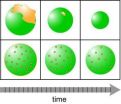(Press-News.org) Researchers have pieced together new genetic clues to the arthritis puzzle in a study that brings potential treatments closer to reality and could also provide insights into why more women than men succumb to the disabling condition.
Rheumatoid arthritis – which affects more than 400,000 people in the UK and about 1% of the world's population – is a complicated disease: lifestyle and environmental factors, such as smoking, diet, pregnancy and infection are thought to play a role, but it is also known that a person's genetic makeup influences their susceptibility to the condition.
Scientists at the Arthritis Research UK Epidemiology Unit at The University of Manchester have discovered 14 new genes that can lead to rheumatoid arthritis, adding to the 32 other genes they had already identified; the team believes it has now discovered the vast majority of disease-causing genes for the condition.
The Manchester researchers' latest study, published in the journal Nature Genetics, has identified genes specific to the female X-chromosome – which could explain why three times more women than men present with the disease.
First author Dr Stephen Eyre said: "This work will have a great impact on the clinical treatment of arthritis; we have already found three genes that are targets for drugs, leaving a further 43 genes with the potential for drug development, helping the third of patients who fail to respond well to current medications.
"Although patients who first present at clinic have similar symptoms, it is likely that their route to developing disease has involved a varied path. The genetic findings can help divide patients into smaller groups with more similar types of rheumatoid arthritis and assist in the allocation of therapies and disease management."
The Manchester team used advanced technology and a large collection of international samples to identify the new genes and move a step closer to being able to improve the lives of rheumatoid arthritis sufferers.
Professor Jane Worthington, study lead based at the NIHR Manchester Musculoskeletal Biomedical Research Unit, said: "This groundbreaking study brought together scientists from around the world and involved the use of DNA samples from more than 27,000 patients with rheumatoid arthritis and healthy controls. As a result of our findings, we now know that genetic variations at over 45 regions of the genome determine susceptibility to this form of arthritis.
"We observed remarkable similarities with genetic markers associated with other autoimmune diseases. Our future work will focus on understanding how the simple genetic changes alter normal biological processes and lead to disease. Ultimately, this will help us to develop novel therapies and improved targeting of existing drugs."
Professor Alan Silman, medical director of Arthritis Research UK, said: "This large genetics study has added a significant amount to the current knowledge of the genetic basis of rheumatoid arthritis. We hope that this research will lead to a greater understanding of the disease and allow us to develop targeted drug treatments for the half-a-million people currently living with rheumatoid arthritis.
"This is the first time that a genetic association has been established between rheumatoid arthritis and the X chromosome. This could provide a useful clue in helping us to understand why rheumatoid arthritis is three times more likely to occur in women."
###
Notes for editors:
A copy of the paper, 'High-density genetic mapping identifies new susceptibility loci for rheumatoid arthritis,' published in Nature Genetics, is available on request.
Arthritis Research UK is the leading authority on arthritis in the UK, conducting scientific and medical research into all types of arthritis and related musculoskeletal conditions. It is the UK's fourth largest medical research charity and the only charity solely committed to funding high quality research into the cause, treatment and cure of arthritis.
For more information visit www.arthritisresearchuk.org
The NIHR Manchester Musculoskeletal Biomedical Research Unit was created by the National Institute for Health Research in 2012 to move scientific breakthroughs in the laboratory, through clinical assessment into improved outcomes for adults and children with musculoskeletal disorders such as arthritis. As a partnership between Central Manchester University Hospitals NHS Foundation Trust and The University of Manchester, the Biomedical Research Unit is designated as a specialist centre of excellence in musculoskeletal diseases. www.manchestermskbru.org
Arthritis study reveals why gender bias is all in the genes
2012-11-16
ELSE PRESS RELEASES FROM THIS DATE:
Uncommon features of Einstein's brain might explain his remarkable cognitive abilities
2012-11-16
TALLAHASSEE, Fla. Portions of Albert Einstein's brain have been found to be unlike those of most people and could be related to his extraordinary cognitive abilities, according to a new study led by Florida State University evolutionary anthropologist Dean Falk.
Falk, along with colleagues Frederick E. Lepore of the Robert Wood Johnson Medical School and Adrianne Noe, director of the National Museum of Health and Medicine, describe for the first time the entire cerebral cortex of Einstein's brain from an examination of 14 recently discovered photographs. The researchers ...
Study shows large-scale genomic testing feasible, impacts therapy
2012-11-16
DENVER – Targeted cancer therapy has been transforming the care of patients with non-small-cell lung cancer (NSCLC). It is now standard practice for tumor specimens from NSCLC patients to be examined for EGFR mutations and ALK rearrangements to identify patients for therapy with EGFR and ALK inhibitors, respectively. Now, researchers say large-scale genomic testing is feasible within the clinical workflow, impacting therapeutic decisions. The study is published in the December 2012 issue of the International Association for the Study of Lung Cancer's (IASLC) Journal of ...
Study shows bone metastases treatment can improve overall survival
2012-11-16
DENVER – It is common for patients initially diagnosed with lung cancer to have the cancer spread to sites like the liver, brain and bone. One of the most frequent sites of metastases is the bone, with an estimated 30 to 40 percent of patients with non-small-cell lung cancer (NSCLC) developing bone loss. A study published in the December 2012 issue of the International Association for the Study of Lung Cancer's (IASLC) Journal of Thoracic Oncology, shows that the bone metastases drug denosumab was associated with improved overall survival compared with zoledonic acid (ZA). ...
LLNL scientists assist in building detector to search for elusive dark matter material
2012-11-16
Lawrence Livermore National Laboratory researchers are making key contributions to a physics experiment that will look for one of nature's most elusive particles, "dark matter," using a tank nearly a mile underground beneath the Black Hills of South Dakota.
The Large Underground Xenon (LUX) experiment located at the Sanford Underground Research Facility in Lead, S.D. is the most sensitive detector of its kind to look for dark matter. Thought to comprise more than 80 percent of the mass of the universe, scientists believe dark matter could hold the key to answering some ...
Study: Cellphone bans associated with fewer urban accidents
2012-11-16
CHAMPAIGN, Ill. — Cellphones and driving go together like knives and juggling. But when cellphone use is banned, are drivers any safer?
It depends on where you're driving, a study by University of Illinois researchers says.
The study found that, long-term, enacting a cellphone ban was associated with a relative decrease in the accident rate in urban areas. However, in very rural areas, cellphone bans were associated with higher accident rates than would otherwise be expected.
"The main idea is to use the eye test when it comes to cellphone use," says study leader ...
Airborne particles smuggle pollutants to far reaches of globe
2012-11-16
RICHLAND, Wash. -- Pollution from fossil fuel burning and forest fires reaches all the way to the Arctic, even though it should decay long before it travels that far. Now, lab research can explain how pollution makes its lofty journey: rather than ride on the surface of airborne particles, pollutants snuggle inside, protected from the elements on the way. The results will help scientists improve atmospheric air-quality and pollution transport models.
The results also show that the particles that envelop pollutants also benefit from this arrangement. The new study in Environmental ...
Simplifying heart surgery with stretchable electronics devices
2012-11-16
Researchers at the McCormick School of Engineering are part of a team that has used stretchable electronics to create a multipurpose medical catheter that can both monitor heart functions and perform corrections on heart tissue during surgery.
The device marks the first time stretchable electronics have been applied to a surgical process known as cardiac ablation, a milestone that could lead to simpler surgeries for arrhythmia and other heart conditions. The researchers had previously demonstrated the concept to apply stretchable electronics to heart surgery, but with ...
Medical vital-sign monitoring reduced to the size of a postage stamp
2012-11-16
CORVALLIS, Ore. – Electrical engineers at Oregon State University have developed new technology to monitor medical vital signs, with sophisticated sensors so small and cheap they could fit onto a bandage, be manufactured in high volumes and cost less than a quarter.
A patent is being processed for the monitoring system and it's now ready for clinical trials, researchers say. When commercialized, it could be used as a disposable electronic sensor, with many potential applications due to its powerful performance, small size, and low cost.
Heart monitoring is one obvious ...
Video-article shows how to purify magnetic bacteria
2012-11-16
Magnetotactic bacteria, like Magnetospirillum magneticum, have evolved cellular processes that allow them to take up iron molecules to produce magnetic nanocrystals like magnetite. Since they were first discovered and isolated in 1975 by Robert Blakemore, scientists continue to be fascinated by these unique bacteria, whether as a means to isolate biogenic magnetite or to understand the evolutionary advantages of producing these minerals. A new video-article in JoVE (Journal of Visualized Experiments) details a procedure to purify and enrich samples of magnetotactic bacteria ...
Researchers report potential new treatment to stop Alzheimer's disease
2012-11-16
Last March, researchers at UCLA reported the development of a molecular compound called CLR01 that prevented toxic proteins associated with Parkinson's disease from binding together and killing the brain's neurons.
Building on those findings, they have now turned their attention to Alzheimer's disease, which is thought to be caused by a similar toxic aggregation or clumping, but with different proteins, especially amyloid-beta and tau.
And what they've found is encouraging. Using the same compound, which they've dubbed a "molecular tweezer," in a living mouse model ...


